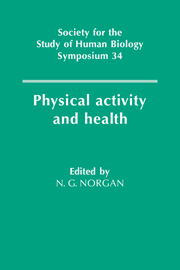Book contents
- Frontmatter
- Contents
- List of contributors
- Acknowledgements
- 1 Introduction
- 2 Comparative aspects of human activity
- 3 Physical activity levels – past and present
- 4 The validity of health measurements
- 5 Developments in the assessment of physical activity
- 6 Two national surveys of activity, fitness and health: the Allied Dunbar National Fitness survey and the Welsh Heart Health survey
- 7 Physical development and childhood activity
- 8 Physical activity and behavioural development during childhood and youth
- 9 Physiological aspects of activity and ageing
- 10 Activity and morale in later life: preliminary analysis from the Nottingham Longitudinal Study of Activity and Ageing
- 11 The benefits of low intensity exercise
- 12 Physical activity, obesity and weight maintenance
- 13 Adherence to physical activity and exercise
- 14 Women's working behaviour and maternal-child health in rural Nepal
- 15 Physical activity and psychological well-being
- 16 Leisure lifestyles: present and future
- Index
9 - Physiological aspects of activity and ageing
Published online by Cambridge University Press: 05 December 2011
- Frontmatter
- Contents
- List of contributors
- Acknowledgements
- 1 Introduction
- 2 Comparative aspects of human activity
- 3 Physical activity levels – past and present
- 4 The validity of health measurements
- 5 Developments in the assessment of physical activity
- 6 Two national surveys of activity, fitness and health: the Allied Dunbar National Fitness survey and the Welsh Heart Health survey
- 7 Physical development and childhood activity
- 8 Physical activity and behavioural development during childhood and youth
- 9 Physiological aspects of activity and ageing
- 10 Activity and morale in later life: preliminary analysis from the Nottingham Longitudinal Study of Activity and Ageing
- 11 The benefits of low intensity exercise
- 12 Physical activity, obesity and weight maintenance
- 13 Adherence to physical activity and exercise
- 14 Women's working behaviour and maternal-child health in rural Nepal
- 15 Physical activity and psychological well-being
- 16 Leisure lifestyles: present and future
- Index
Summary
Old age is associated with increased morbidity which is well documented; it is also associated with a decrease in customary physical activity which is less well described. The assessment of customary activity levels is not easy even in young individuals many of whom participate regularly in sport; it is much more difficult in old individuals for whom walking is usually their most active pursuit.
There are a number of approaches which have been reviewed (Patrick, 1985). They range from direct methods using simple postal questionnaires to indirect methods which depend on logging bio-signals which are related to activity level such as heart rate or foot-fall (Patrick et al., 1986). Questionnaires may be of dubious validity in the elderly since they often have poor short-term recall, and there is no single bio-signal which has good predictive power for a variety of different activities. There is no ideal approach despite some sophisticated techniques. Assessment of metabolic rate using labelled water promises to provide the best method but awaits validation for old people. Customary activity therefore has to be described within the limitations of the measurement technique.
Retirement from full-time employment marks a change in lifestyle which may be associated with changes in activity level. It is a potential watershed for a reduction in activity which could lead to declining function and so to further reductions in customary activity, forming a vicious circle of deterioration.
- Type
- Chapter
- Information
- Physical Activity and Health , pp. 121 - 128Publisher: Cambridge University PressPrint publication year: 1992
- 2
- Cited by

